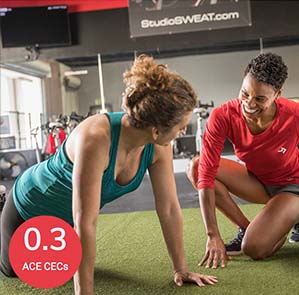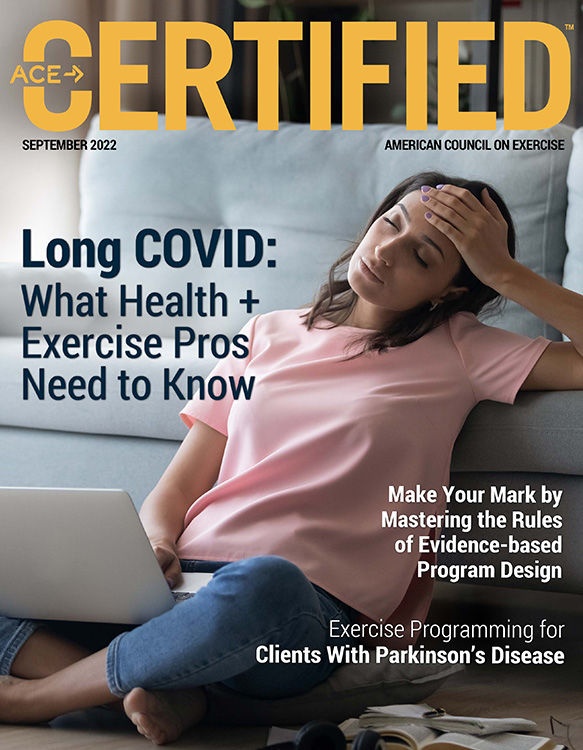
In our digitally dominated world, accessing health and fitness information is swift, simple and immediate. Information is available for consumption around the clock via multiple social media and video platforms, websites and podcasts. Of course, accessibility comes with some pretty significant drawbacks. Specifically, it can be tough to differentiate between quality, science-based information and the often-questionable advice of those who may boast a wide following but don’t always use credible research to back up their claims.
For this reason, social media can be a double-edged sword for health and exercise professionals. While these platforms help to boost your visibility and reach, they also force you to compete with philosophies and “programs” sold by uncredentialed social media “fitness gurus” or “insta-influencers” who typically espouse approaches that overpromise and underdeliver. It doesn’t help that they’ve mastered the art of making pseudo-science messages look flashy and effective. Combatting this misinformation is a key step in increasing the quality of the content our clients (and prospective clients) consume.
Of course, doing so is no mean feat, but it can be done. In this article, we examine the consequences of social media influence, outline specific program design rules overlooked by fit-fluencers that you can use to create quality programs, and offer action steps you and your clients can take to identify and avoid garbage science.
The Good, The Bad and the #Fitspiration Consequences
For both you and your clients, social media offers a wide range of benefits. As a health and exercise professional, these platforms allow you to make and nurture connections with clients and other professionals, publish content to share your expertise and engage your audience, expand your reach and communicate quickly and openly. These same platforms also provide your clients with a host of information and advice on how to make healthy lifestyle changes and improve overall health.
Clearly, when social media is used appropriately and intentionally, everyone can benefit. That said, social media offers an equally long list of cautions. For example, social media can be:
- Time consuming
- Distracting
- Emotionally disconnected (difficult to sense emotion from others)
- Not always a safe space to share
- Sometimes inauthentic (the insta-influencer)
- Negative (demotivating messages or images)
Arguably, you have the greatest potential to influence your clients’ experience with these last two points. Research suggests that exposure to inauthentic and negative content can result in increased body dissatisfaction, among both men and women. This type of content is generally driven by fitness models and female celebrities, and evidence indicates that #fitspiration and influencer content is perceived by consumers as the “ideal” standard or representation of health and fitness. When clients see these images, it encourages them to think, “If I do X, then I will look like Y.” While your education and training help you recognize the fallacy of this type of thinking, it isn’t surprising that clients might be highly influenced by false and unrealistic promises. After all, few of us are impervious to the notion of a quick and easy fix.
The Evidence-based Rules That Insta-influencers Neglect
It’s unlikely we will ever eradicate the insta-influencer or the content they create. And that really is not the goal. The goal is to educate our clients, so they are empowered and adequately informed to make evidence-based decisions that lead them to establish sustainable (and healthy) behaviors.
To accomplish this goal, we start by teaching and applying evidence-based rules in every program design. But before we get into the specifics of a client’s program, we need to prioritize three umbrella principles, which should inform your practice and guide you in developing an effective and individualized plan:
- Goal-driven focus – Does the workout or program connect to a client’s goal (or goals)? Is the goal a process goal or a product goal?
- Client likes/dislikes – Does the workout or program consider what a client will enjoy?
- Sustainable and logical – Does the workout or program present sustainable practices and a logical sequence?
After you ensure that the approach you are taking with each client is goal-driven, has considered the client’s likes and dislikes, and is sustainable and logical, you are ready to design a solid program.
Rule #1 – The Basics Still Work
Before you work to strengthen a client’s body, you need to evaluate their basic movement patterns (bend-and-lift, single-leg, pushing, pulling and rotational movements). If clients are unable to effectively complete these movement patterns, functionality should be restored before the body is loaded and asked to perform at a higher level within the context of more complex movements.
Rule #2 – Simplify
A fun and effective workout or training regimen does not need to be complicated. You do not need every piece of equipment or weighted implement to “tone” (a word the insta-influencer loves to throw around) muscles. Rather, a set of dumbbells, resistance bands and a cordless jump rope may be all you need to create a safe and effective program for many of your clients.
Rule #3 – Efficiency
As a well-trained professional, you understand the value of maximizing a client’s time, energy and focus during a workout session. It’s not uncommon to see insta-influencers promote long workouts and ask followers to “commit to at least 60 minutes of cardio a day.” As you well know, most clients simply do not have that amount of time (which isn’t necessary for physical gains or fat loss) to devote to just cardio. Unless a client has a specific performance goal that is related to competition, prioritize their window of time and work within their availability.
Rule #4 – Leverage Body Weight
Body weight can be an effective and useful source of resistance and it can and does have a valid place in a well-rounded program. Body-weight exercises can be combined to create a total-body resistance-training workout or incorporated into time-efficient high-intensity interval training or Tabata workouts.
Rule #5 – Client Goals
Each client has specific goals, and their workout programs should be designed to help them achieve those goals. While many influencers might espouse a single “ideal” program, there is no one-size-fits-all approach. After all, some clients may want to focus on endurance, while others want to boost their energy levels and develop a sense of vitality. A program must first consider the goal (which is why being goal driven is a principle and a rule).
Rule #6 – 3D Approach
A quality program encourages three-dimensional movement by including exercises that occur in the frontal, sagittal and transverse planes. The human body moves front-to-back, laterally and rotationally. A well-designed program includes movements that maximize strength, balance and efficiency in all directions.
Rule #7 – Flexibility
Flexibility is an often-overlooked health-related component of fitness. Dynamic warm-up or movement prep should occur at the beginning of a workout and static stretching/cool-down exercises should occur at the end. It isn’t all about the lift or the load. To lift effectively, the joints need to move through an optimal range of motion; flexibility exercises improve a joint’s range of motion.
Rule #8 – Joyful Movement
Sure, a high caloric burn is awesome, and it feels amazing, but it can be easy for clients to become entangled in the idea that the primary goal of working out is to burn calories or to earn a meal. However, the point of a workout session is not about the burn. It’s about movement that is functional, enjoyable and connected to a client’s goals.
The Payoff
By applying these rules, you create programmatic balance, connect directly to client goals, support and respect client preferences, and keep the focus on the process (not the product). This reinforces the most important message that is contrary to social media messages and images: It’s not about the body; it’s about a client’s relationship with their body.
Action Steps for You
Many of us feel compelled to compete with the more visible and highly followed “influencer” because we know their messages are not supported by science. As much as our clients battle to ignore the “noise,” we also battle to silence it. We want the messages we know to be true, reliable and evidence-based to be the messages that speak the loudest. The following four action steps can serve to lead us all—both professionals and clients—in a positive direction:
- Perform a social media cleanse.
- Evaluate your self-perception and language.
- Familiarize yourself with the literature.
- Engage.
First, cleanse your social media feed; unfollow any accounts that do not immediately invoke a feeling of inspiration, motivation or authenticity. Do this with all your feeds.
The next step—which can be a tough one—is to evaluate your self-perception. This is an introspective and reflective process. It’s unlikely we will ever eradicate body-image concerns or the messages that tell us we aren’t enough the way we are (that’s outside our locus of control, right?), but we can do our individual and collective part to take energy away from those self-destructive and distracting messages. Ask yourself: Who is influencing me as a professional? Do I aspire to an image or connect with a process? How do I feel when I see those messages?
Next, dig into the literature on social media influence, fit-spiration and the consequences of both. The literature is compelling and there are arguments on both sides. You would be well served to hear both sides and review multiple perspectives and findings. Finally, share those findings with your clients.
Lastly, engage in these conversations with other colleagues and individuals. Educate and be educated.
Action Steps for Your Clients
As you take these action steps, encourage your clients to walk a similar path. Here are five steps or possibilities to share with clients:
- Encourage a social media cleanse.
- Introduce new language.
- Celebrate the nonscalable victories.
- Remember that process is more important than product.
- Learn to recognize the red flags of diet culture (which reinforces fit-fluencer dogma).
Once you recognize the importance of cleaning your social media feeds and muting the messages you see, you can help your clients do the same. Ask them to thoughtfully evaluate the information they are receiving and teach them ways to seek out more supportive individuals to follow. Take it a step further and share some of your favorite professionals to learn from.
Second, remind your clients that language is an important component to consider when differentiating between positive and negative sources of information. Terms like ripped, toned or skinny (as opposed to strong or energetic, for example) can often be considered red flags. These words focus exclusively on the physical aspects of fitness. Talk to clients about how they feel (for example, energized, excited or connected) versus how they look. Words have power.
Third, encourage clients to celebrate their nonscalable victories, which might include how well they slept or how much water they consumed. This is an effective way to shift the client mindset and keep the focus on the process. Ask clients to reflect on things like how hydrated they felt throughout the day, how many walk breaks they took and how their sleep habits are developing.
Next, emphasize the process over the product or outcome. It’s not uncommon for clients to state that they want to lose weight or tone up. These goals are heavily influenced by the images we consume. If we help clients focus on behavior goals (exercising three times a week vs losing a certain amount of weight), their practices and habits will change and the outcome will follow.
Finally, where there’s an insta-influencer, there are underpinnings of diet culture. Help clients recognize (and reject) the red flags and the “neon words” that are associated with diet culture language, such as detox, fast results, clean, and good/bad foods.
The Take-home Truths
This discussion reveals three truths: First, fancy doesn’t always get results. Consistency and progression are key. Second, most fit-fluencers are focused on the image. Authenticity is essential and keeping the focus on providing solutions versus selling products is the value proposition you offer. Finally, it is credentials, science and education that matter—not the number of followers you accrue.
Expand Your Knowledge
 |
The ACE Functional Training Specialist Program is designed for fitness and allied health professionals who want to gain a deeper understanding of how to train the body to move more efficiently. You will learn how to apply functional movement techniques into your training, including understanding fascia, assessments, the application of appropriate exercise progressions and stretching techniques that will help you train clients to move more smoothly.
|
 |
The ACE Integrated Fitness Training® (ACE IFT®) Model is a program design blueprint that has evolved with the needs of today’s exercise professionals and their clients. The ACE IFT Exercise Programming Toolkit course bundle explores the different components of the ACE IFT Model, including the ACE Mover Method, to help you develop safe and effective exercise plans. By gaining an understanding of how to move through the phases of the ACE IFT Model, you will be able to effectively educate clients and gain their trust, keeping them safe as they move toward their goals.
|





 by
by 




